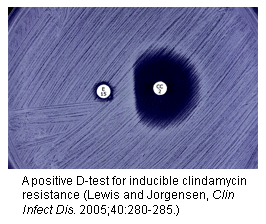An ongoing dialogue on HIV/AIDS, infectious diseases,
June 15th, 2012
ID Learning Unit — The D Test
I suppose it’s not surprising that we’d follow-up the Etest with the D test, though perhaps if I were being alphabetical, the order would have been reversed.
 The D test is important, because it screens for a form of clindamycin resistance in MRSA that might otherwise not be detected — the “inducible” kind, which can be associated with treatment failures. About half of MRSA isolates have this form of resistance.
The D test is important, because it screens for a form of clindamycin resistance in MRSA that might otherwise not be detected — the “inducible” kind, which can be associated with treatment failures. About half of MRSA isolates have this form of resistance.
Here’s how it works:
- Take some erythromycin-resistant, clindamycin-“sensitive” MRSA, spread it on a culture plate
- Drop an erythromycin disk on the left side of the plate, and a clindamycin disk on the right
- If there’s a flattening of the zone of inhibition between the two disks, then the test is positive, confirming inducible clindamycin resistance
- Report that bug as clindamycin resistant
First, critical thinkers will wonder why this is important, since we obviously don’t give erythromycin with clindamycin to an actual patient. My big-picture explanation is that it’s a marker for easily inducible resistance even without the erythro being present.
And second, note the critical step of putting the clindamycin disk on the right — otherwise the shape of the zone of inhibition won’t be a “D”, and everyone will be confused because who knows what to call that shape.
(That second part was a joke.)


So I have to bite. Erythromycin induces the rRNA methylase, and I’m assuming maybe other macrolides do as well, but what are the other drugs/factors we are worried about that may cause the inducible resistance and thus clinical failure?